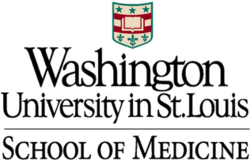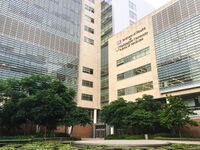Washington University School of Medicine
Topic: Organization
 From HandWiki - Reading time: 7 min
From HandWiki - Reading time: 7 min
 | |
| Type | Private |
|---|---|
| Established | 1891 |
Parent institution | Washington University in St. Louis |
| Dean | David Perlmutter, MD |
Academic staff | 1874 |
| Students | 1349 (including 605 MD [183 MD/PhD] and 267 OT, 278 PT) |
| Location | St. Louis , Missouri , United States |
| Campus | Urban |
| Website | medicine |
Washington University School of Medicine (WUSM) is the medical school of Washington University in St. Louis in St. Louis, Missouri. Founded in 1891, the School of Medicine has 1,260 students, 604 of which are pursuing a medical degree with or without a combined Doctor of Philosophy or other advanced degree. It also offers doctorate degrees in biomedical research through the Division of Biology and Biological Sciences. The School has developed large physical therapy (273 students) and occupational therapy (233 students) programs, as well as the Program in Audiology and Communication Sciences (100 students) which includes a Doctor of Audiology (Au.D.) degree and a Master of Science in Deaf Education (M.S.D.E.) degree.[1] There are 1,772 faculty, 1,022 residents, and 765 fellows.[citation needed]
The clinical service is provided by Washington University Physicians, a comprehensive medical and surgical practice providing treatment in more than 75 medical specialties. Washington University Physicians are the medical staffs of the two teaching hospitals – Barnes-Jewish Hospital and St. Louis Children's Hospital. They also provide inpatient and outpatient care at the St. Louis Veteran's Administration Hospital, hospitals in the BJC HealthCare system and 35 other office locations throughout the greater St Louis region.
U.S. News and World Report ranks the college high;[2] the school is currently ranked 6th for research[3] and has been ranked as high as 2nd in 2003 and 2004,[4] It has been listed among the top ten medical schools since rankings were first published in 1987. The school ranks first in the nation in student selectivity.[5] Globally, the school is ranked as the 20th and 35th best medical program in 2020 by the Times Higher Education’s World University Rankings for medicine and QS World University Ranking for medicine, respectively.[6][7]
Faculty
17 Nobel laureates have been associated with the School of Medicine. 12 faculty members are fellows of the National Academy of Sciences; 30 belong to the Institute of Medicine. 92 faculty members hold individual career development awards from the National Institutes of Health (NIH). 59 faculty members hold career development awards from non-federal agencies. 14 faculty members have MERIT status, a special recognition given by the National Institutes of Health that provides long-term, uninterrupted financial support to investigators. 6 faculty members are Howard Hughes Medical Institute investigators.
History
Medical classes were first held at Washington University in 1891 after the St. Louis Medical College decided to affiliate with the University, establishing a Medical Department. Robert S. Brookings, a University benefactor from its earliest days, devoted much of his work and philanthropy to Washington University and made the improvement of the Medical Department one of his primary objectives. This especially became a cause for concern after an early 1900s Carnegie Foundation report derided the organization and quality of the Medical Department.[8]
Following a trend in medical education across the country, research and the creation of new knowledge became a stated objective in a 1906 course catalog for the medical department. For Brookings and the University, incorporating the Medical Department into a separate School of Medicine seemed to be the next logical step. This process began in 1914 when facilities were permanently moved to their current location in St. Louis's Central West End neighborhood in 1914, and was completed in 1918 with the official naming of the School of Medicine.[9] The first female faculty member seems to have been biochemist and physiologist Ethel Ronzoni Bishop, who became an assistant professor in 1923.[10]
The Medical School began its escalation from regional renown in the 1940s, a decade when two Nobel Prizes were awarded, in 1944 and 1947, to groups of faculty members. In 1950, a Cancer Research Building was completed, being the first major new building addition to the School of Medicine since its relocation in 1914. More buildings were added in that decade, and in the 1960s the School of Medicine focused on diversifying its student body by graduating its first African-American student and substantially increasing the percentage of graduating students who are female to nearly 50%.[9]
In March 2020, Washington University School of Medicine announced the construction of a new $616 million, 11 story, 609,000-square-foot neuroscience research building which will sit at the eastern edge of the Medical Campus in the Cortex Innovation Community. Construction of the building is set to be finished in 2023.[11]
Campus
Washington University Medical Center comprises 164 acres (0.5 km²) spread over approximately 17 city blocks, located along the eastern edge of Forest Park within the Central West End neighborhood of St. Louis. Barnes-Jewish Hospital and St. Louis Children's Hospital, part of BJC HealthCare, the teaching hospitals affiliated with the School of Medicine, are also located within the medical complex. Many of the buildings are connected via a series of sky bridges and corridors. As of 2008, the School of Medicine occupies over 4,500,000 square feet (420,000 m2) in the entire medical complex.[12]
Washington University and BJC HealthCare have taken on many joint venture projects since their original collaboration in the 1910s. The Center for Advanced Medicine, completed in December 2001, is one such collaboration, which houses the Alvin J. Siteman Cancer Center. At 650,000 square feet (60,000 m2), it is one of the largest single buildings in the Medical Complex.[13]
In the expansive Medical Complex are several especially large buildings. Recently completed is the 700,000-square-foot (65,000 m2) BJC Institutes of Health, of which Washington University's Medical School will occupy several floors. It is the largest building constructed on Washington University's campus. Called the BJC Institute of Health at Washington University, it will house the University's BioMed 21 Research Initiative, five interdisciplinary research centers, laboratories, and additional space for The Genome Center.[14]
Prominent buildings, centers, and spaces at the medical campus includes Barnes-Jewish Hospital, the Central Institute for the Deaf, St. Louis Children's Hospital, Rehabilitation Institute of Saint Louis, Siteman Cancer Center, Center for Advanced Medicine, Charles F. Knight Emergency and Trauma Center, and the Eric P. Newman Education Center.
The Medical Complex is accessible via the Central West End MetroLink station, which provides transportation to the rest of Washington University's campuses.
Nobel laureates
Physiology or Medicine
- 1943: Edward A. Doisy (1893–1986), Faculty of Medicine, 1919–1923
- 1944: Joseph Erlanger (1874–1965), Chairman, Department of Physiology 1910–1946
- 1944: Herbert Gasser (1888–1963), Faculty of Medicine, 1916–1931
- 1947: Carl F. Cori (1896–1984), Faculty of Medicine 1931–1984
- 1947: Gerty T. Cori (1896–1957), Faculty of Medicine 1931–1957
- 1959: Arthur Kornberg, Chairman, Department of Microbiology, 1952–1959
- 1959: Severo Ochoa, Faculty of Medicine 1940–1942
- 1969: Alfred Hershey (1908–1997), Faculty of Medicine 1934–1950
- 1971: Earl Sutherland (1915–1974), M.D. 42, Resident in Internal Medicine 1943–1945, Faculty of Medicine, 1945–1953
- 1974: Christian de Duve, Faculty of Medicine 1946–1947
- 1978: Daniel Nathans (1928–1999), M.D. 54
- 1978: Hamilton O. Smith, Washington University Medical Service 1956–1957
- 1980: George D. Snell, Faculty of Arts and Sciences 1933–1934
- 1986: Stanley Cohen, Faculty of Arts and Sciences 1953–1959
- 1986: Rita Levi-Montalcini (1909–2012), Faculty of Arts and Sciences, 1948–1977[15]
- 1992: Edwin G. Krebs, M.D. 43, Resident in Internal Medicine and then a Research Fellow in Biological Chemistry 1945–1948
- 1998: Robert F. Furchgott, Ph.D. Faculty of Medicine, 1949–1956
Chemistry
- 1970: Luis F. Leloir, Faculty of Medicine 1944
- 1980: Paul Berg, Faculty of Medicine 1954–1959
- 2012: Brian Kobilka, Resident in Internal Medicine, 1981–1984
Notable alumni
- Alexis F. Hartmann, MD '21; pediatrician, biochemist and former professor of pediatrics
- Ewald W. Busse, MD ’42; psychiatrist and dean of Duke University School of medicine
- Earl Sutherland, MD '42; biochemist and winner of the Nobel Prize in Physiology or Medicine
- Edwin G. Krebs, MD ’43; biochemist and winner of the Nobel Prize in Physiology or Medicine
- David W. Talmage, MD ’44; immunologist
- Helen Elizabeth Nash, MD, PhD '45; pediatrician; dean of minority affairs at Washington University School of Medicine
- Ernst Wynder, MD '50; linked smoking with lung cancer[16]
- Daniel Nathans, MD ’54; microbiologist and winner of the Nobel Prize in Physiology or Medicine and National Medal of Science
- James E. Darnell Jr., MD ’55; molecular biologist and winner of the National Medal of Science
- Selna Kaplan, MD ’55; pediatric endocrinologist
- Thomas Hornbein, MD ’56; mountaineer and chairman of anesthesiology at University of Washington School of Medicine
- Clay Armstrong, MD ’60; physiologist and winner of the Albert Lasker Award for Basic Medical Research for describing K+ channels
- Floyd E. Bloom, MD ’60; chairman emeritus of neuropharmacology at Scripps Research Institute and editor-in-chief of Science
- Pedro Cuatrecasas, MD ’62; inventor of affinity chromatography and winner of the Wolf Prize in Medicine
- C. Garrison Fathman, MD ’69; clinical immunologist
- Philip O. Alderson, MD ’70; dean of Saint Louis University School of Medicine
- Jonathan Mann, MD ’74; head of the World Health Organization global AIDS program
- Dan R. Littman, MD, PhD ’80; immunologist, HHMI investigator, member of the National Academy of Sciences and the Institute of Medicine
- Eric D. Green, MD, PhD ’87, HS ’91; director of the NHGRI
Other associated hospitals
- St. Louis Children's Hospital
- Alvin J. Siteman Cancer Center
- Barnes-Jewish West County Hospital
- Barnes-Jewish St. Peters Hospital
- Christian Hospital
- Northwest HealthCare
- Metropolitan St. Louis Psychiatric Center
- Missouri Baptist Medical Center
- St. Louis Shriner's Hospital
See also
- Washington Manual of Medical Therapeutics
References
- ↑ "Programs". pacs.wustl.edu. Washington University in St. Louis. http://pacs.wustl.edu/pacs/pacsweb.nsf/9ec55b62f7c029f5862573a9006ad75a/f4bd1aaf96bb84cc86256d09005a3e27?OpenDocument. Retrieved 11 November 2011.
- ↑ "Best Graduate Schools | Top Graduate Programs | US News Education". Grad-schools.usnews.rankingsandreviews.com. http://grad-schools.usnews.rankingsandreviews.com/grad/occ/search. Retrieved March 13, 2013.
- ↑ "Best Medical Schools: Research". U.S. News. http://grad-schools.usnews.rankingsandreviews.com/best-graduate-schools/top-medical-schools/research-rankings. Retrieved 2012-08-07.
- ↑ "Historical Medical School Research Rankings". U.S. News. http://www.adminplan.northwestern.edu/ir/data-book/v44/1.08-usnews-med-rankings.pdf. Retrieved 2013-03-17.
- ↑ "FACTS – Washington University School of Medicine". Medicine.wustl.edu. June 30, 2011. http://medicine.wustl.edu/about/facts. Retrieved March 13, 2013.
- ↑ "Best universities for medicine 2020". November 19, 2019. https://www.timeshighereducation.com/student/best-universities/best-universities-medicine. Retrieved March 22, 2020.
- ↑ "Medicine". 2019. https://www.topuniversities.com/university-rankings/university-subject-rankings/2019/medicine. Retrieved March 22, 2020.
- ↑ "Medical Campus Tour". Washington University in St. Louis. http://www.wustl.edu/tour/medicine/.
- ↑ 9.0 9.1 Anderson, Paul; Marion Hunt. "Origins and History of the Washington University School of Medicine". Washington University Medical School, Bernard Becker Medical Library. http://beckerexhibits.wustl.edu/wusm-hist/about.htm. Retrieved 2008-07-22.
- ↑ "Ethel Bishop Ronzoni". Washington University. Archived from the original on 5 June 2010. https://web.archive.org/web/20100605111211/http://awn.wustl.edu/distingfaculty/11ronzoni.pdf. Retrieved 6 May 2012.
- ↑ "Washington University to break ground on major neuroscience research hub" (in en). 2020-03-06. https://medicine.wustl.edu/news/washington-university-to-break-ground-on-major-neuroscience-research-hub/.
- ↑ "Facilities". Washington University in St. Louis. http://medschool.wustl.edu/pages/?page=overview#facilities.
- ↑ "Washington University Medical Center". Washington University in St. Louis. http://neuro.wustl.edu/education/adultresidency/medicalcenter.htm.
- ↑ Ericson, Gwen (October 30, 2007). "Immense new facility to house BioMed 21 research at Washington University Medical Center". Medical Public Affairs. http://mednews.wustl.edu/news/page/normal/10418.html.
- ↑ "Missouri Women in the Health Sciences - Biographies - Rita Levi-Montalcini". http://beckerexhibits.wustl.edu/mowihsp/bios/levi_montalcini.htm.
- ↑ "Ernst Wynder, 77, a Cancer Researcher, Dies". https://www.nytimes.com/1999/07/16/us/ernst-wynder-77-a-cancer-researcher-dies.html. Retrieved 2013-02-14.
External links
[ ⚑ ] 38°38′13″N 90°15′53″W / 38.6370°N 90.2646°W
 KSF
KSF

